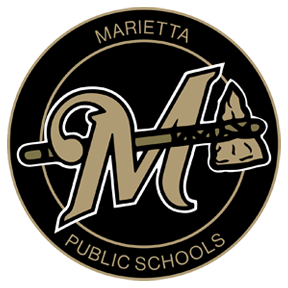To meet the ever-increasing need for a skilled workforce in Oklahoma’s growing aviation and aerospace industry, several of the state’s public schools – Marietta included – have added aerospace programs to their curriculum.
Marietta’s classes, taught by Erin Hansen, and with support from the district administration and information technology department, has further expanded by adding flight simulators, which effectively bridge the gap between having technical knowledge and the application of that knowledge.
“It’s one thing to learn from a handout in class, but totally different to use the simulator,” said Hansen. “You may learn the terminology, but until you apply it, you don’t really know. So much of it is muscle memory – learning to gently steer the plane – and the simulator helps with that muscle memory.”
Because the simulators allow for different views of the plane, students can watch from behind using the chase view and see exactly how the plane responds as they work the controls from inside. There’s a lot going on inside a cockpit, and a pilot has to use hands and feet to steer the plane, all the while watching a myriad of gauges on the inside, as well as what’s going on outside the plane. It’s like simultaneously patting your head and rubbing your tummy, but hopping on one foot, too.
“Someone can tell you, but until you actually do it, you don’t understand,” Hansen stated. “Everybody crashes and burns their first few ties, but better there than in a real plane.”
Flying is something that Hansen has loved since she was introduced to it in a high school class. Because the lessons were cost prohibitive, she wasn’t able to pursue the passion.
“That’s one reason I want our program to be more practical,” she explained. “I want our students to get their commercial drone license first, because it’s part of what they need to earn for their pilot’s license. Then, if they want, they can move on and get their student pilot’s license. That’s the path I’m encouraging.”
Hansen said that the program’s success – including the flight simulators – wouldn’t be possible without the encouragement and support of her administration and IT department, headed by Nate Jackson.
Jackson, the district’s own Dr. Victor Frankenstein – for the literary challenged, that’s not the monster, but the man who used spare parts to create it – has long been known for making lemonade out of lemons and stretching the technology budget until it squeaks, and when it came to the simulators, his modus operandi was much the same.
“Back in the fall, I asked Mrs. Hansen if she thought her students would benefit from a simulator. The first one, we sourced ourselves from pieces of things we had here,” Jackson clarified. “I actually brought my home video card because they’re in high demand right now and hard to get. We got it together and the kids flew using the Smart Board.”
After building the first simulator and seeing what a valuable asset it was, Jackson and his department, which includes assistant Josh Jones and student interns like Rocky Valenzuela, who’s also a student in Hansen’s class, assembled two more simulators – again, using “sourced” components – some in Jackson’s boneyard, some found elsewhere.
“The tech department is 110 percent behind us,” insisted Hansen. “Nate came to me and said, ‘I think we can do this for you, with Mrs. Naylor’s support,’ and before long, we had a simulator. And then we had two more.”
According to Superintendent Brandi Naylor, the component parts of the three simulators were funded with grant proceeds, but the impetus for the project lies with Jackson’s department and Hansen’s curriculum.
“Our district is blessed to have Erin Hansen, Nate Jackson, and the rest of the IT department,” said Naylor. “Because of their vision and their desire to see our students succeed, they’re willing to go the extra mile to make that happen, and we will support that kind of initiative every chance we get.”
The results of that “initiative” are that the school now has three operational flight simulators for their aerospace program, and because of Jackson’s “sourcing”, all three cost much less than they should’ve. That squeaking sound you hear is the technology budget, stretched to the max, and it’s music to Naylor’s ears.
“We have three amazing machines, and because of Nate Jackson and his department, our cost was about half the purchase price of one complete simulator,” concluded Naylor.
For Jackson, the simulators are a way to support STEM classes, which cover a lot of area that he’s passionate about.
“I enjoy supporting what she’s teaching,” he said, “and taking the parts that other people don’t find value in and making something out of it, it’s what I do a lot of the time, and I think that’s why it’s so easy to support what she does in her classes.”
For Hansen, who’s been teaching off-and-on since 1990, the simulators are another tool to use in teaching a subject that she enjoys and sees value in.
“I love teaching – the variety, the challenge, trying to find out how kids learn,” she said. “I just love my job.” And for the district, Hansen and Jackson are a dynamic duo, one that leaves everyone wondering what they’ll come up with next.

